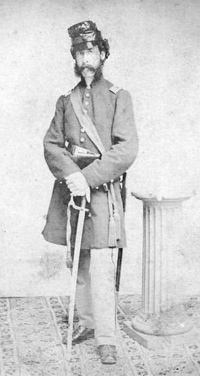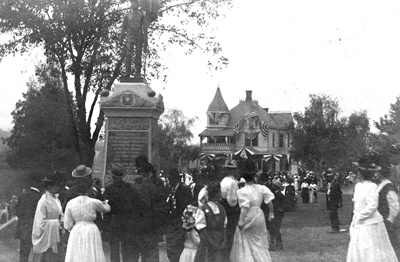The Civil War’s Ulster Guard
Winter 2011

CW Soldier James Talmidge Hendricks, photo from the Seward R. Osborne collection
The Civil War was like most arguments — each side had its points, and both the Union soldiers and the Confederates faced off confidently and steadfastly. Modern day history buffs, military servicemen (and women), and bored college students can all make up their minds about which side they would have fought for based on their own patriotism, view of human rights, religion and politics. But you can understand the life of a civilian-turned-solider without forming an in-depth opinion of the Civil War. Besides, chances are that many of the volunteers who made up the 20th New York State Militia didn’t know—or care—about the origins of the war. They signed up for combat to prove they could, to say they did, and ultimately, to fight.
Brave volunteers from Kingston and surrounding rural towns banded together to create the Ulster Guard, also called the 20th New York State Militia (N.Y.S.M.), led by Colonel George Pratt*, immediately following the firing at Fort Sumter that jumpstarted the Civil War. Originally termed to only serve for three months, from April 28th to August 2nd in 1861, these novices eventually became veterans—and heroes—after being officially inducted into the United States military and serving for three additional years.
This impromptu unit was in the field for the first time in their lives after leaving behind lucrative jobs and loving families. Despite their enthusiasm, questions of discipline and ability were raised. The members of any given military unit are expected to function as a family, and without training or experience, it was doubtful that the Ulster Guard could act as one in-sync brood.
On top of their unpreparedness, the Ulster Guard was naive—they wanted to fight, to go head-to-head with their enemies, without understanding the heartbreaking realities of war… or what they were in for down the line.
Luckily for the new soldiers—and their wives— there was no combat during the initial three months. Other than an incident that occurred on Front Street in Kingston, when the Ulster Guard was fired upon, the volunteers had a tame taste of war. Not without a unique set of frustrations, though.
On April 23rd, the Ulster Guard was ordered to report to Washington, D.C. by May 3rd. After waiting in New York City for transportation from April 20th to May 5th, their orders were (temporarily) revoked. Washington only wanted volunteers who had signed on for two years, and the 20th N.Y.S.M. was no longer needed. After 24 hours of upset, the Guard got their wish and were given orders to proceed to battle. After guarding the Annapolis railroad, serving picket duty and standing guard in Baltimore, the militia returned home, greeted by members of the U.S. military, firemen and Rondout locals.
When Colonel Pratt offered the Ulster guard a three-year term, they quickly accepted. After being re-equipped and outfitted in legit uniforms, they were welcomed as part of the United States Service and officially designated as the 80th New York Volunteers. What started as a soft introduction to wartime turned into three bloody years in Maryland, Virginia and Pennsylvania. Long hours, scarce food, endless hours of marching and weighted baggage rounded out their experience as real-deal soldiers. Moments of terror were trailed by excruciatingly long periods of boredom. The team of soldiers that started out green and unsuspecting got their wish of being enveloped by combat and grappling for their allegiance to the North.
Author Lindsay Pietroluongo is a Freelance writer in the Hudson Valley. Email her at lindsaypietro@gmail.com.
* See Seward R. Osborne’s Colonel George Watson Pratt: American Patriot

Aaron Rhodes, a veteran of the 80th Infantry, donated the land on 9W in Highland for erection of a Civil War memorial statue in honor of his brother Theodore’s 156th NYS Volunteers. Theodore Rhodes, age, 19 years, enlisted, August 19, 1862 at Plattekill to serve three years. He mustered in as private, in Co. A, November 17, 1862; promoted corporal, May 13, 1863, and sergeant, June 18, 1864. He died November 11, 1864 at Ulster County, NY. This photo was taken on September 8th, 1909 at the statue’s dedication. The 156th New York Infantry Regiment lost 4 officers and 56 enlisted men killed or mortally wounded and 3 officers and 164 enlisted men to disease. Aaron enlisted in the 80th Infantry at Poughkeepsie, age 18, was wounded at Antietam, September 17, 1862, and returned to action. He was discharged March 11, 1865. , Aaron’s house in the background of photo was demolished in 2002. Roster information is from the annual reports of the NYS Adjutant General’s office online.
Photo from the Vivian Yess Wadlin Collection
